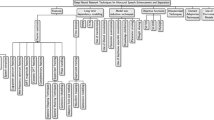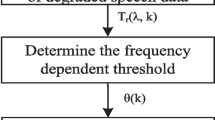Abstract
Acoustic feedback, or signal leakage between the loudspeaker and microphone of hearing aids, creates some irritations to the users of these devices and degrades the performance of the hearing aids. Among various methods proposed to cancel the negative effect of acoustic feedback, Instrumental Variable Method Adaptive Feedback Canceller (IVM-AFC) has shown superb performance. IVM-AFC exploits two kinds of adaptive filters to pre-filter the signals and to estimate the feedback path transfer function, respectively. This AFC method typically uses Partitioned Block Frequency Domain Normalized Least Mean Square (PBFD- NLMS) algorithm for the feedback path estimation. In this paper, two alternative algorithms are introduced in addition to PBFD-NLMS. One is Discrete Fourier Transform Multi-Delay block Frequency domain NLMS (DFT-MDF-NLMS) algorithm not used for this application before. The other one is a new delayless sub-band filtering algorithm. The algorithms are evaluated using speech as the input of hearing aid. Based on the experimental results, the new sub-band filtering method possesses low computational complexity and high capability of tracking the changes in the feedback path.









Similar content being viewed by others
References
Waterschoot, T. V., & Moonen, M. (2011). Fifty years of acoustic feedback control: state of the art and future challenges. Proceedings of the IEEE, 99(2), 288–327.
Schroeder, M. R. (1964). Improvement of acoustic-feedback stability by frequency shifting. Journal of Acoustic Society of America, 36(9), 1718–1724.
Patronis, E.T., & Jr. (1978). Acoustic feedback detector and automatic gain control. U.S. Patent 4079199.
Duong, T.K., Lefort, E., & Bellanger, M.G. (1984). Acoustic feedback cancelling electro-acoustic transducer network. U.S. Patent 4485272.
Spriet, A., Rombouts, G., Moonen, M., & Wouters, J. (2006). Adaptive feedback cancellation in hearing aids. Journal of Franklin Institute, 343, 545–573.
Spriet, A. (2004). Adaptive filtering techniques for noise reduction and acoustic feedback cancellation in hearing aids. Thesis in Katholieke Universiteit Leuven.
Ibaraki, S., Furukawa, H., & Naono, H. (1988). Howling canceller. U.S. Patent 4747132.
Kates, J. M. (1990). Feedback cancellation in hearing aids. IEEE International Conference on Acoustics, Speech, and Signal Processing, 2, 1125–1128.
Khoubrouy, S. A., & Panahi, I. M. S. (2012). Order selection of the hearing aid feedback canceller filter based on its impulse response energy. IEEE Engineering in Medicine and Biology Society Conference, 2012, 5218–5221.
Morgan, D. R., Hall, J. L., & Benesty, J. (2001). Investigation of several types of nonlinearities for use in stereo acoustic echo cancellation. IEEE Transactions on Speech and Audio Processing, 6, 686–696.
Siqueira, M. G., & Alwan, A. (2000). Steady-state analysis of continuous adaptation in acoustic feedback reduction systems for hearing-aids. IEEE Transactions on Speech and Audio Processing, 8(4), 443–453.
Waterschoot, T. van, Eneman, K., & Moonen, M. (2005). Instrumental variable methods for acoustic feedback cancellation. Katholieke Universiteit Leuven, Leuven, Belgium, Tech. Rep. ESAT-SISTA TR 05-14.
Spriet, A., Poudler, I., Moonen, M., & Wouters, J. (2005). Adaptive feedback cancellation in hearing aids with linear prediction of the desired signal. IEEE Transactions on Signal Processing, 53, 3749–3763.
Proakis, J.G., & Manolakis, D.G. (2007). Digital Signal Processing Principles, Algorithms, and applications. New Jersey: Prentice Hall, 4th edition, 846-876.
Sayed, A. H. (2008). Adaptive filters. New Jersey: Wiley.
Milani, A. A., Panahi, I. M. S., & Loizou, P. C. (2009). A new delayless subband adaptive filtering algorithm for active noise control systems. IEEE Transactions on Audio, Speech and Language Processing, 17, 1038–1045.
Khoubrouy, S. A., Panahi, I. M. S., & Milani, A. A. (2011). A new delayless Sub-band filtering method for cancelling the effect of feedback path in hearing Aid systems. IEEE Engineering in Medicine and Biology Society Conference, 2011, 7920–7923.
Chan, K. S., & Farhang-Boroujeny, B. (2001). Analysis of the partitioned frequency-domain block LMS (PFBLMS) algorithm. IEEE Transactions on Signal Processing, 49, 1860–1874.
Gupta, S., Tang, Y., Paramesh, J., & Allstot, D. J. (2012). Multi-rate polyphase DSP and LMS calibration schemes for oversampled ADCs. Journal of Signal Processing Systems, 69, 329–338.
Chan, S. C., & Zhou, Y. (2009). Convergence behavior of NLMS algorithm for Gaussian inputs: solution using generalized abelian integral functions and step size selection. Journal of Signal Processing Systems, 59, 255–265.
Morgan, D. R., & Thi, J. C. (1995). A delayless subband adaptive filter architecture. IEEE Transaction Signal Processing, 43(8), 1819–1830.
Huo, J., Nordholm, S., & Zang, Z., (2001). New weight transform schemes for delayless subband adaptive filtering. In Proc. GLOBECOM’01, New York, 197–201.
Enerman, K., & Moonen, M. (2003). Iterated partitioned block frequency-domain adaptive filtering for acoustic echo cancellation. IEEE Transactions on Speech and Audio Processing, 11, 143–158.
Scheirer, E., & Slaney, M. (1997). Construction and evaluation of a robust multifeature speech/music discriminator. IEEE Transactions on Acoustics, Speech, and Signal Processing, 2, 1331–1334.
van Waterschoot, T., Rombouts, G., Verhoeve, P., & Moonen, M. (2007). Double-talk-robust prediction error identification algorithms for acoustic echo cancellation. IEEE Transactions on Signal Processing, 55(3), 846–858.
Loizou, P.C. (2007). Speech Enhancement Theory and Practice. Boca Raton: Taylor and Francis Group 55-66 and 399-401.
Acknowledgments
The experiments have been made on two actual feedback path models received from Starkey laboratory.
Author information
Authors and Affiliations
Corresponding author
Rights and permissions
About this article
Cite this article
Khoubrouy, S.A., Panahi, I.M.S. An Efficient Delayless Sub-band Filtering for Adaptive Feedback Compensation in Hearing Aid. J Sign Process Syst 83, 401–409 (2016). https://doi.org/10.1007/s11265-015-1028-y
Received:
Revised:
Accepted:
Published:
Issue Date:
DOI: https://doi.org/10.1007/s11265-015-1028-y




